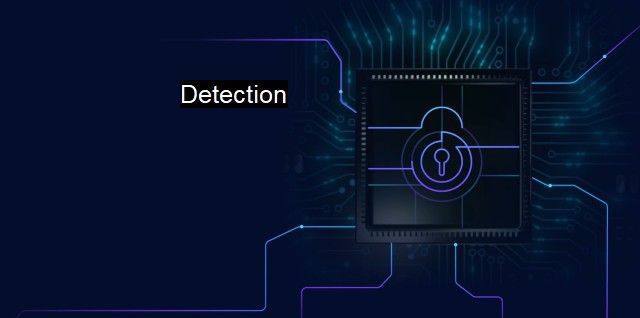What is Detection?
The Importance of Detection in Cybersecurity and Antivirus Software: Identifying and Preventing Malware Threats
Detection, particularly is a critical mechanism to safeguard systems and networks against malicious activities. This concept revolves around the technology and processes adopted to identify and respond to potential attacks that jeopardize data security integrity. Thus, hold a fundamental role in the cybersecurity infrastructure that businesses install to protect their confidential data and information systems.Cyber detection refers to the strategies and systems implemented to uncover cyber threats. These threats manifest in many forms, including viruses, malware, ransomware, phishing attacks, pri rogues, rootkits, bootkits or any unscrupulous code or software aimed at compromising systems' vulnerability. the main objective of detection is to identify these threats as early as possible so swift corrective measures can be taken to neutralize them.
Detection methods hinge extensively on antivirus and other cybersecurity software. Antivirus detections work by scrutinizing the overall technoscape and highlighting the anomalies. This software systematically scans systems for specific sequences of code, known as signatures, linked to known malware or viruses. Once these signatures are identified, the antivirus can then isolate and eliminate that particular threat. The purpose behind this detection practice is to prohibit malicious software or unauthorized users from accessing, altering, or intercepting data.
Since developing a new virus or malware signature takes time, the reliance on signatures hence yielded to an advanced intelligent method, known as heuristics. Rather than merely searching for known signatures, Heuristics analysis investigates the behavior of files and programs to locate clues that indicate potential malicious activity. This detection type has proven effective against zero-day threats, which doesn't have a known signature available but behaves in a way similar to the recognized malicious software.
Detection furthermore takes place on an intrusion level with Intrusion Detection Systems (IDS). These systems monitor network traffic, detecting possible threats based on predefined policies or unusual activity patterns. IDS split into two categories: Network Intrusion Detection Systems (NIDS) and Host Intrusion Detection Systems (HIDS). NIDS assess the traffic across the entire network, while HIDS analyze activities on an individual system. Implementing these systems aids in timely identifying breaches in the network to thwart attackers from accessing sensitive data.
To depict anomalies to the acceptable baseline user behavior, Antivirus software can employ behavior-based detection or Anomaly detection models. A deviation from behavior considered normal signals a threat. To verify this, Anomaly detection algorithms use Machine Learning or Statistical Algorithms regularly updated for accurate analysis. a significant challenge of anomaly-based detection is its susceptibility towards generating false alarms.
The complexity and persistence of cyber threats make defensive measures like detection crucial in maintaining the integrity of a business or organization's data. Continuous vigilance, regular system updates, and investment in advanced detection technology help prepare against the ever-evolving panorama of cyber threats. Entities should carry out regular audits and embrace Threat Hunting practices to identify potential weaknesses and maintain robust systems as compromised systems can have severe effects.
Though detection holds the frontlines in a competent cybersecurity structure, it is only the beginning. After reconnoitering threats, applying quick remediation is an essential sequential step to hinder threat exploitation and mitigate damage.
Detection in cybersecurity operates on multiple levels, using various tools and strategies, including antivirus programs, anomaly detection, and intrusion detection systems. It's crucial to construct a comprehensive understanding of detection to ensure robust security and remain resilient amidst the growing scale of cyber threats.

| | A | | | B | | | C | | | D | | | E | | | F | | | G | | | H | | | I | | | J | | | K | | | L | | | M | |
| | N | | | O | | | P | | | Q | | | R | | | S | | | T | | | U | | | V | | | W | | | X | | | Y | | | Z | |
| | 1 | | | 2 | | | 3 | | | 4 | | | 7 | | | 8 | | |||||||